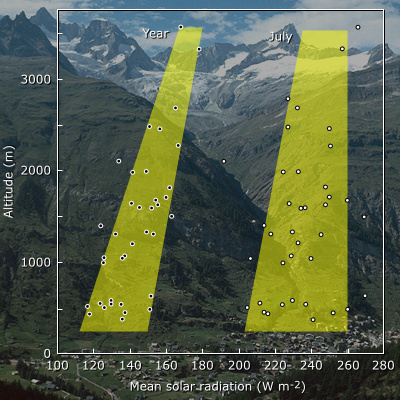Solar radiation
Elevational gradients
Outside the earth's atmosphere, solar radiation is 1.4 times as intense as at the earth's lowland surface on a clear day. Since mountains protrude into heights of reduced turbidity, the sky gets darker blue, and the sun becomes more intense the higher one climbs. However, clouds and fog become more abundant as well.
Consequently, there is no globally uniform elevational gradient of the dose of radiation measured at ground level. The gradient seen in winter in the Alps is partially influenced by the screening of the horizon due to low solar angle and lowland fog.
Distinguish:
- G, total ("global") radiation (Wm-2)
- PAR, the photosynthetically active part of global radiation (Wm-2), 400-700 nm, c. half of the total)
- PFD, photon flux density, in the 400-700 nm range corrected for wavelength-specific differences in energy of photons (μmol photons m-2s-1, all photons given equal weight, hence the molar unit)

Note: There is no significant difference in the relative frequency of certain photon flux densities at different altitudes.
Across all weather types, cloudiness compensates for the clear day increase of radiation with altitude in the Alps in summer.


Direct vs. diffuse radiation
In contrast to the overall mean (dose) of radiation, short term maximum intensities of visible radiation and the UV-fraction increase with elevation, particularly under foggy conditions (diffuse radiation, sun burn despite clouds).
Clouds matter
Depending on the region, alpine vegetation may experience more or less radiation than lowland vegetation. In some very dry areas of the globe (no clouds), the long-term dose of radiation increases with altitude. In some very humid regions, solar radiation decreases with altitude. An example is in the tropical mountains of New Guinea, where the alpine flora is exposed to only one third of the average radiation captured by tropical lowland plants.


To understand alpine radiation climate:
- Cloudiness is the key; it often reduces radiation below lowland intensities.
- Maximum radiation increases with elevation.
- The UV-B fraction increases with elevation.
